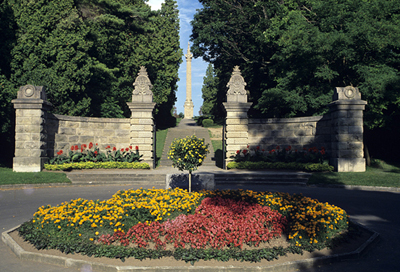Queenston Heights National Historic Site of Canada
Niagara-on-the-Lake, Ontario

Queenston Heights, general view
© Parks Canada / Parcs Canada
Address :
14184 Niagara Parkway, Niagara-on-the-Lake, Ontario
Recognition Statute:
Historic Sites and Monuments Act (R.S.C., 1985, c. H-4)
Designation Date:
1968-06-19
Dates:
-
1812 to 1812
(Construction)
-
1814 to 1814
(Significant)
Event, Person, Organization:
-
Battle of Queenston Heights
(Event)
-
War of 1812
(Event)
-
Major/General Sir Isaac Brock
(Person)
-
Lt/Col. John Macdonnell
(Person)
-
Laura Secord
(Person)
-
William Thomas
(Architect)
Other Name(s):
-
Queenston Heights
(Designation Name)
-
Queenston Heights Battlefield
(Other Name)
-
Redan Battery
(Other Name)
-
Fort Drummond
(Other Name)
-
Battle of Queenston Heights
(Plaque name)
Research Report Number:
1965-004; 1963-015; 1962-037
DFRP Number:
56483 00
Plaque(s)
Existing plaque: Brock's monument, 14184 Niagara Parkway, Ontario
In enduring memory of Sergeant Charles Merryweather and Privates Thomas Haynes and David Jones of the Forty-First Regiment of Foot, Privates Richard Frickleton, Thomas Gee, Martin Hall, Thomas Levins, John Merrick, William Newman, John Smith and Richard Wade of the Froty-Ninth Regiment of Foot, Private Henry Cope of the Second Regiment of York Militia, Private Thomas Smith of the Third Regiment of York Militia, Ayanete and Kayentatirhon, Cayuga Chiefs, Ta Kanentye, Onodaga Warrior, Kayarawagor and Sakangonguquate, Oneida Warriors, killed in action here, 13th October 1812.
Existing plaque: 14184 Niagara Parkway, Niagara-on-the-Lake, Ontario
In the early morning of 13 October 1812, American troops under Major-General Stephen Van Rensellaer crossed the Niagara River and took possession of Queenston Heights. Major-General Isaac Brock hurried from Fort George to lead a small force against the invaders and was killed in an attempt to regain the heights. In the afternoon, Major-General Roger Hale Sheaffe with his force of British regulars, militia and Indians from Fort George strengthened by reinforcements from Chippawa, took the hill from the west flank, capturing 958 prisoners. This celebrated victory ended the American offensive of 1812.
*Note: This designation has been identified for review. A review can be triggered for one of the following reasons - outdated language or terminology, absence of a significant layer of history, factual errors, controversial beliefs and behaviour, or significant new knowledge.
Description of Historic Place
Queenston Heights is an extensive hillside area on the Niagara escarpment, centred on a heavily wooded, landscaped park which includes an elegant 57.9 metres (190 foot), classical column containing Sir Isaac Brock's grave. The park marks the site of the Battle of Queenston Heights in the War of 1812.
Heritage Value
Queenston Heights was declared a national historic site of Canada because: the Battle of Queenston Heights was fought here when an attempted invasion by American troops was repulsed by British/Canadian forces early in the War of 1812, the importance of Queenston Heights, and the difficulty of achieving a meaningful historic interpretation at Lundy's Lane, renders this the main battlefield to be interpreted in commemorating the War of 1812 in the Niagara Peninsula.
The heritage value of Queenston Heights National Historic Site of Canada resides in the completeness of the found forms and spatial inter-relationships of the remaining cultural landscape of the large area over which the battle was fought. This includes the landing place in Queenston, the locations of the defending British batteries, the portage road, the Redan battery, the cliffs, the slope upon which the British charges were made and where Major/Gen. Brock and Lt/Col. Macdonnell died, Sheaffe's march, and the Heights where the British victory was secured. Fort Drummond, a feature of Queenston Heights, has been separately recognized as a national historic site of Canada.
Sources: HSMBC Minutes, June 1968; Commemorative Integrity Statement, 1989.
Character-Defining Elements
Key features contributing to the heritage value of this site include: the cultural landscape as a product of its parts including archaeological remains, natural landscape, built landscape features including military defence works, the portage road, the Redan Battery and Fort Drummond, the spatial relationships of these resources, the found forms of the Redan Battery, including its earthworks, breastworks and expense magazine, the found forms, materials, and associated earthworks of Fort Drummond, the remains of Vrooman's Battery, the natural features of the site relevant to the battle, including the landing place at Queenston, the cliffs, the slope upon which British charges occurred, Sheaffe's route of march, and the plateau on the Heights, the found form, route, and continuing legibility of remnants of the portage road from Queenston to Chippewa, the viewplanes of the portage road from the Battery, from the Heights to Lewiston and to Queenston, from the road from Niagara-on-the-Lake Brock's Monument, and from the Redan Battery to the Niagara River, the memorials including early markers, the Laura Secord Memorial, and Brock's Monument, Brock's Monument in its Queenston limestone material and high level of craftsmanship, including its Neoclassical design as a 57.9 metres, fluted Composite order column on a rusticated stone basement and sculpted pedestal; its low enclosing wall with 6.1 metres, classical "trophy" statues at the corners; the 4.9 metres statue of Brock; the functional design as observation tower with interior staircase lit by loopholes ascending to the viewing platform; the ground-floor entry and crypt with granite floor slabs.